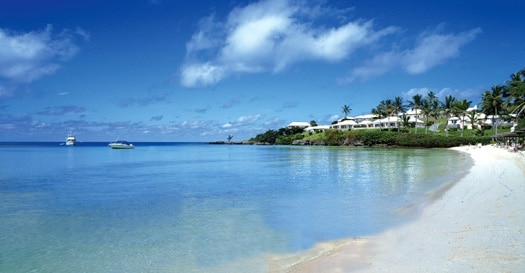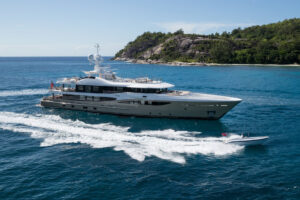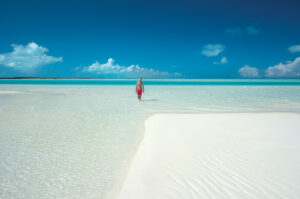
The private cottages of Cambridge Beaches.
Friday, June 16, marks an extraordinary century for ocean racing and Yachting magazine. On that day, a record fleet of more than 200 yachts gathers off Newport for the start of the Newport/Bermuda ocean race. This biennial 630-mile thrash to the island has done more to shape offshore and ocean racing around the world than any other events-save the Transpac race to Hawaii, also celebrating its centenary this year.
The idea of recreation sailing over the horizon was first championed by Thomas Fleming Day, the controversial editor of The Rudder magazine, founded in 1891. Using his pages as a forum to encourage others to take up his challenge, Day observed: “Men owning large schooners contentedly sail them in narrow ponds, and of the thousands of yachts afloat, scarcely 20 percent ever go out of sight of their home ports. This repetition of action is not only having a deleterious effect upon the craft, but is slowly sapping the manhood of the sport and affecting the spirit and skill of all engaged in the pastime.”
In 1904, Day organized a race from Sandy Hook, New Jersey, to Marblehead, Mass., by way of the Nantucket Shoals Light Vessel, a daring 330-mile chase that attracted six entries-and columns of criticism in the New York and Boston papers, thinking such an event was an invitation to death and disaster. Unperturbed, he set up a second event a year later from Brooklyn to Hampton Roads, Va., and blasted back at his critics. “Newspaper men ought to know better than to consult a lot of gray-bearded rum-soaked piazza scows. What do these miserable old hulks who spend their days swigging booze on the front stoop of a clubhouse know about the dangers of the deep? If they make a voyage from Larchmont to Cow Bay in a 10-knot breeze, it is the event of their lives, an experience they never forget and never want to repeat.”
This printed banter did wonders for promoting the concept of racing beyond the sight of land-as well as the readership figures. After the Hampton Roads Race, which had attracted nine yachts, owners turned to Day for something more ambitious. “A real ocean race, one that would take them well offshore and into blue water.” Day needed little encouragement, and with help from Sir Thomas Lipton, who provided the $500 Lipton Cup for the winner, the Bermuda Race was born in 1906. The following year Yachting started up and eventually became the Bermuda Race’s chronicler of record as well as the world’s pre-eminent yachting magazine.
The first race drew vociferous criticism from the press and the public, much as Day’s other races had done. Some citizens were so upset that they sent memorial wreaths and undertakers business cards to men who planned to enter. Despite this, three yachts-Lila, Gauntlet and Tamerlane-appeared for the start at 3 p.m. on Saturday, May 26, 1906.
Day damned the entrants with faint praise: “These three have been getting ready for some weeks and were supposed to be in the best shape for the long tussle. Of the three, Tamerlane is the best model for this sort of work. Lila is too hard and Gauntlet too slack-bilged. ”
Day was certainly right about Lila. Soon after the start, she suffered damage to the rigging, forcing her to return in the company of Tamerlane, whose crew set out again for Bermuda the following Tuesday. This 38-foot yawl, owned by Commodore Frank Maier of the Eastern Yacht Club, also carried Day, who reported in the July issue of The Rudder on an uneventful passage that took five days, six hours, and nine minutes-an average of 5.22 knots. Tamerlane won the first trophy.
For the 1907 race, restrictions were relaxed to allow professionals on board, but amateurs still had to form the afterguard, as they have done ever since. In this second running, 12 boats started in Gravesend Bay. Dervish won the large class, and Lila took the small class, while Day, in a prelude of things to come, powered to Bermuda in a motorboat.
The First World War forced so many big yachts to be laid up that the event was not held again until 1923, when Herbert L Stone, editor of Yachting, took up the challenge of reinstating the race.Twenty-three yachts came to the line off New London, Conn., and ran straight into a storm, which, far from frightening off the entrants, simply added to the fascination and folklore that has built up around the race ever since.
The event became a biennial one, beginning in 1926. That year also marked the participation of the Cruising Club of America which, until then, had been held back from cohosting the race with the Royal Bermuda YC by internal protests about racing. Much of its membership then (and still) believed the club should not promote racing. The progressives eventually won that argument and the Cruising Club continues to this day to coordinate the race with their Bermudian partners.
The Depression took its toll, and for the 1936 race the organizers moved the start to Rhode Island to avoid the unpredictable winds and the strong tides of Long Island. A storm, however, hit the fleet in the Gulf Stream, dismasting 10 boats-still a record. This led the CCA to review its safety regulations, and many of the rig and equipment regulations put into place remain embodied in the ISAF Offshore Safety Regulations. The CCA also introduced a revised handicap system and advised yachtsmen to install modern radios for safety. The 1938 race was the last to be held until World War II ended.
Many great sailors and designers have made their mark in the Bermuda Race. Rod and Olin Stephens were regular competitors, and Germ·n Frers Sr. encouraged an increasing number of South American owners to compete in his designs during the 50s and 60s. His son, Germ·n Jr., remains one of the dominant designers with seven winners to date, including the record-breaking maxi Boomerang II. Famous sailmaker and America’s Cup skipper Ted Hood won a notable victory in 1968 with his one-tonner Robin.
Handicapped finishes aside, the “other” race has always centered on the glory of being first across the line. Huey Long’s Ondine set a 67-hour, 58-minute record in ’74. Nirvana, campaigned by Bermudian Marvin Green, sliced five hours and 29 minutes off the record in 1982. This record stood until George Coumantaros aboard his 86-foot Frers-designed maxi Boomerang II completed the course in 57 hours, 31 minutes and 30 seconds to win both elapsed and handicap honors. As he lifted the Lighthouse Trophy for the first time after 21 previous attempts, the smile on the face of this New York-based Greek shipping magnate stretched from ear to ear. “It has been like Jason chasing the Golden Fleece,” he said. “Winning the Lighthouse Trophy has always been one of my big ambitions in life.”
Roy Disney’s Reichel Pugh-designed Pyewacket chalked up another first in 2002 after making the most of the unusual close-reaching conditions that year to complete the 635 miles in 53 hours, 39 minutes and 22 seconds. This record still stands, alongside Pyewacket’s other record for the Transpac race set the previous year: the first time a yacht had competed and won the two successive American ocean races.
This year’s entries include Dominick Porco’s Swan 45 Alliance, the defending St. David’s Lighthouse winner, and the 90-foot line honors contender Maximus. Designed by Greg Elliot, it has a swing keel and rotating wing mast. The “David” in this contest will be the 66-foot Reichel Pugh swing keel ultralight Stark Raving Mad owned by Jim Madden.
Among the guests of honor this year will be designers Olin Stephens and Germ·n Frers. Sir John Vereker, the Governor of Bermuda, will be donning his Rail Meat cap once more to race aboard Colin Couper’s Swan 46 Babe and TV commentator Gary Jobson will co-skipper the 80-foot maxi Sagamore, now renamed Rabbit.
Today, we live in a world where global, single-handed and televised races occur simultaneously, their wakes criss-crossing and names changing as sponsors come and go. The Bermuda Race stays the same and throws the highest wake. And that’s the way it should be.
Bermuda Calling? Here’s How
Tie Up The Royal Bermuda Yacht Club, one of the world’s oldest, is headquarters for the Bermuda Race with 110 new floating docks. Tie up at its Point Pleasant Marina ($3 per foot per night). www.rbyc.bm
Tuck In In Hamilton, stay at the rather formal Waterloo House (www.waterloohouse.com), with guest privileges at the exclusive Coral Beach Club. Try Elbow Beach Club (www.mandarinoriental.com) or Ariel Sands (www.arielsands.com), which belongs to actor Michael Douglas’ family. For utter peace at the western end of the island, Cambridge Beaches has private cottages with “personal beaches” (www.cambridgebeaches.com); so do the more casual cabanas of Nine Beaches (www.9beaches.com).
Dine Out Before she became one of Bermuda’s most celebrated chefs, Judith Wadson was an intern at Chez Panisse in San Francisco and an editor at Yachting. Her Aggie’s Garden & Waterside CafÈ in Pembroke serves organic produce from her brothers’ farm. For more formal fare, try Waterloo House in Hamilton or head out to Aqua at Ariel Sands. Don’t leave Bermuda without drinking a Bermuda Dark & Stormy: ginger beer and locally made Goslings rum.
Dive In They don’t call it the Bermuda Triangle for nothing: Dive the dozens of wrecks that settled in crystal clear waters. Bermuda IV, a 94-foot Hargrave Cheoy Lee, is one of the few luxury charter yachts based here and from April through September cruises the surrounding waters. The yacht’s crew offers dive courses, from basic PADI certification to “night diver” to the new category, “Wreck Historian.” When you’re done, five-star meals and accommodations are on board, along with a hot tub. Cost per person is $2,750 for five days.








